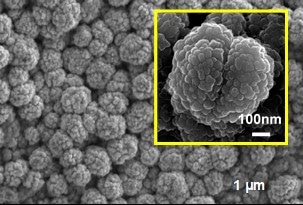Aug 29 2016
A research group led by Naoki Fukata, a Leader of Nanostructured Semiconducting Materials Group at the International Center for Materials Nanoarchitectonics (MANA), NIMS, and a research group at the Georgia Institute of Technology jointly developed an anode material for lithium (Li)-ion rechargeable batteries by forming nanoparticles made of silicon (Si)-metal composites on metal substrates. The resulting anode material had high capacity - almost twice as high as conventional materials - and a long cycle life. These results will lead to the development of higher-capacity, longer-life anode materials for Li-ion rechargeable batteries.
 Scanning electron microscope image of a nanostructured silicon-metal composite developed in this study as a new anode material for Li-ion rechargeable batteries. (Credit: National Institute for Materials Science (NIMS))
Scanning electron microscope image of a nanostructured silicon-metal composite developed in this study as a new anode material for Li-ion rechargeable batteries. (Credit: National Institute for Materials Science (NIMS))
At present, carbon-based materials are used as anodes for Li-ion rechargeable batteries, and their capacities are up to 370 mAh/g. In theory, their capacities can be increased by more than 10 times to 4,200 mAh/g, provided that pure Si is used as an anode material. However, pure Si is highly expandable, three to four times by volume, during the process in which Li ion is incorporated into it. Due to this property, pure silicon anode materials are prone to crack as a large amount of stress is applied to them during repeated charge-discharge cycles, and therefore the use of bulk pure Si as an anode material severely shortens battery cycle life. Consequently, pure Si had not been used up until recently.
The joint research groups formed one-dimensional germanium (Ge) nanowires on metal substrates and then created nanostructured Si-metal composites using the nanowires as a base material layer. The formed nanostructured material is characterized by numerous cavities existing inside aggregated nanoparticles of about several tens of nanometers to a hundred nanometers. There also are larger cavities present between the Si-metal composites and the Ge nanostructures (Fig. 1). Another characteristic is that the material consists of not only pure Si but also metal atoms (mainly iron) that are spontaneously provided from the substrate via the underlying Ge nanostructures and incorporated into the growing Si material, forming silicon-metal composites.
Based on the evaluations of charge-discharge properties of fabricated samples, the research groups confirmed that the capacity of the new anode material was about double the capacity of current anode materials, and its cycle life was also extended compared to conventional materials.
The new material is capable of increasing both the capacity and life of Li-ion rechargeable battery anodes. The research groups attained these features by creating internal cavities in the material, which act as buffer space to absorb stress generated by the expansion of pure Si, and by regulating the composition of Si and metal elements in the Si-based nanostructure.
This study was published in the online version of NANO Energy on May 6, 2016.
Source: http://www.nims.go.jp/